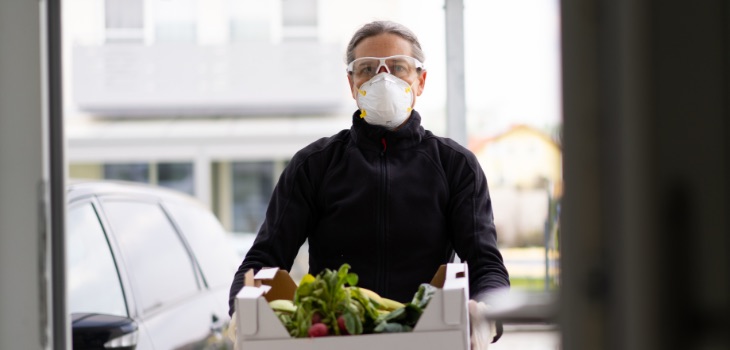Volunteer Engagement Amid The COVID-19 Pandemic
Posted Thursday, April 30th, 2020 by Sterling Volunteers Staff

Nonprofits are rushing to respond to the coronavirus pandemic, and each organization is facing its own unique changes. Some are reducing services, some expanding; some are cancelling events, while others are announcing new online options. Remember we are all in this together and we’re here to help you develop your plan.
In a recent webinar, which is now available on-demand, nonprofit expert Beth Steinhorn, President of VQ Volunteer Strategies, expressed a note of gratitude and shared impacts of the coronavirus pandemic on volunteer engagement across the nonprofit sector.
Impact of the Pandemic
There have been sweeping changes in three key areas of nonprofits amid the COVID-19 crisis.
Changes in mission-driven services
The impacts are far-reaching for many organizations, including those that have had to reduce services due to closures. such as museums and theaters that have had to cancel cultural programs, and animal shelters that continue to care for animals, but must cancel the educational programs and community outreach that are vital to their service.
We also see surges in demand for services such as meal delivery for isolated families, financial assistance due to increased unemployment, and workforce-readiness programs for everyone who will now be looking for work. Other organizations are shifting an in-person approach to virtual mode. Such as CASA workers who are now conducting their visits as virtual check-ins.
Changes in volunteer workforce and schedule
Many organizations have experienced significant losses in their volunteer workforce, but it’s our job as nonprofit leaders to navigate this new world and provide guidance – to be ready to explore new technologies. We must offer our volunteers grace and support as we navigate this new territory.
Changes in the way we do business
VolunteerMatch ran a survey discussing the pandemic in March, receiving 720 responses and more than a thousand comments from nonprofits, volunteers, and corporate responsibility representatives. Findings show significant changes in the way nonprofits are operating:
- 93% of nonprofits have already reported heavy reductions
- 85% of volunteers were afraid of getting ill or exposing others
- 50% of volunteers still wanted to help in person
- 45% of volunteers wanted to volunteer virtually
We’ve seen a balancing-out between the reduction of availability of volunteers, and an increase of offers to volunteer by new volunteers. How we tap into these new volunteers in ways that are strategic, but safe, and compliant with new guidelines and regulations is important.

Organizational Responses
Now is the time to consider new protocols for volunteers and new procedures to deliver services, while being thoughtful and strategic about risk management and stewarding your resources wisely.
There are examples from all around the country of organizations who have responded quickly with new protocols. Such as meal delivery services that were structured to provide meals to homebound individuals within their homes that are now implementing “knock-and-drop” protocols and temperature screening.
We’ve also seen organizations implement new procedures. The previously mentioned CASA workers are great examples – they shifted from virtual to in-person visits, conducting phone calls with younger children and teleconferences with older, depending on local guidelines surrounding social media.
Centralized services can help to streamline the user experience and more quickly mobilize volunteers in support of urgent community needs. We have seen this with how Colorado Responds leveraged the strong partnership between National VOAD, Visionlink, and Sterling Volunteers to help service organizations screen and deploy COVID-19.
Considerations and Tips
We’re here to help you develop your plan as your organization responds to the pandemic. Some tips to consider:
Adjust practices to protect staff, volunteers, and the community such as implementing hand washing stations as necessary, implementing physical distancing, and discontinuing group volunteer opportunities.
Plan for a workforce shortage. Volunteers are staying home, and we all need to acknowledge the workforce shortage that is likely already happening. If you’re not sure how your organization will be affected, we encourage you to conduct a survey to find out what your volunteers’ plans are, what their technological capabilities are, and how they’d like to stay connected.

Engage new volunteers in existing roles. Disasters have historically inspired people to help, and this pandemic isn’t an exception. People want to do what they can to help, and it’s our responsibility to identify opportunities to engage new volunteers. However, it’s important to not abandon screening, especially when you work with vulnerable populations. There are ways to work with other organizations, your current volunteer corps, and Sterling Volunteers to leverage a pool of pre-screened volunteers who are safe, responsible, and able to serve.
Develop new volunteer opportunities. These opportunities include options such as virtual visits, neighbor-to-neighbor errands, and grocery shopping for homebound folks. They could support anyone who’s homebound.
Support remote volunteering. Virtual volunteering isn’t new, but this is a great opportunity for those who are new to it to learn more about it. Now is the time to institute policies about working remotely, cyber security, etc. For example, if you had volunteers helping with data entry, are there safe ways to provide them limited login and access to those same databases from home so they can continue to help process donations, etc.
Adjust training during the pandemic. Effective online training takes more than simply recording in-person training or making a simple video of a lecture. Develop interactive online trainings and keep volunteers engaged with virtual check-ins, virtual potlucks, videos, and other creative ideas.
Prioritize the work your organization does. Be sure to track and measure the impact of the work that is being done, even during a pandemic.
Always support each other. Remember to pause for words of encouragement and expression of gratitude, especially as we face this time of stress and uncertainty.
Develop your own response plan Here’s a template that was adapted from the City of Fort Collins, Colorado, to help you get started:
- Current State
- Assets (staff, volunteers, technology, etc.)
- Community needs
- Challenges (temporarily discontinued volunteer opportunities and services)
- Opportunities to engage volunteers to respond to community needs
- Internal needs to develop and implement those opportunities (technology, messaging, support, etc.)
- Needed resources (support, buy-in, space, money, technology, equipment, etc.)
- Communications plan
- Action plan
- Timeline
- Check-In Plan
Watch the Webinar On-demand To learn more, watch the “Volunteer Engagement Amid the Coronavirus Pandemic” webinar.
Connect with us on Facebook, Twitter, LinkedIn.
The information contained herein is for informational purposes only. Sterling is not a law firm, and none of the information contained in this notice is intended as legal advice. Clients are encouraged to consult with their legal counsel about the impacts of any requirements. This, and other important information can be found on the Sterling website at sterlingcheck.com.
